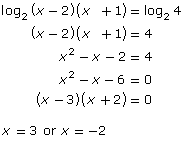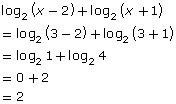In Try This 2 you may have used the product law to write the left side of the equation as a single logarithm.
log2 (x − 2)(x + 1) = 2
There is more than one method you could use to solve this equation.
Method 1: Change to Exponential Form |
Method 2: Change the Right Side
to a Single Logarithm |

|
Since 2 = log2 22 or 2 = log2 4, 2 = log2 4 replaces the right side.

|
The same solutions are found using Method 1 or Method 2. Are these solutions correct?
Determine the restriction from the original equation, log2 (x − 2) + log2 (x + 1) = 2. Remember from Lesson 5 that the logarithm of a negative number is undefined.

Always check to see if the solutions are defined for the equation.
The solutions found algebraically are x = −2 and x = 3. The solution x = −2 must be extraneous since it is a restricted value. Therefore, x = 3 is the solution.
You can also verify your solutions by substituting each into the original equation and checking whether the left side of the equation equals the right side of the equation.
Substitute x = −2.
| LS |
RS |

|
2 |
Left Side ≠ Right Side
Since the logarithm of a negative number is undefined, the solution x = −2 is extraneous.
Substitute x = 3.
| LS |
RS |

|
2 |
Left Side = Right Side
So, the solution is x = 3.
Read “Example 1” on pages 406 to 408 of the textbook. Notice the following while reading:
- Part a, Method 2 shows a graphical solution. This is a way to solve, but the focus of this lesson is on using algebraic methods to solve equations.
- Part b shows two methods. One method changes both sides of the equation to logarithms, and the second method changes the equation to exponential form. Which method do you prefer?
Self-Check 1
- Complete “Your Turn” at the end of “Example 1” on page 408 of the textbook. Answer
- Complete questions 4.a., 4.c., and 6 on page 413 of the textbook. Answer
- Complete question 12 on page 414 of the textbook. Answer
- Complete the numerical response question Solving Logarithmic Equations.

In Lesson 2 you examined how to solve exponential equations. In some cases the bases were powers of one another, and in other cases the bases were not powers of one another. When the bases were not powers of one another, you estimated different values and then checked to see which solution was correct.
Do you think there is a more efficient way to solve exponential equations in which the bases are not powers of one another?
In Try This 3 you will investigate two different methods that can be used to solve exponential equations.
Try This 3
Complete questions 4 to 8 from “Part B: Explore Exponential Equations” on pages 405 to 406 of the textbook.
 Save your responses in your course folder.
Save your responses in your course folder.
Share 2
With a partner or group, share your responses to Try This 3, and then discuss the following question:
Which method could be considered the more “universal” method or the method that would work most consistently for any exponential equation? Discuss advantages and disadvantages for this method.
 If required, save a record of your discussion in your course folder.
If required, save a record of your discussion in your course folder.





